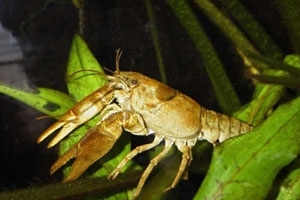White-clawed crayfish (Austropotamobius pallipes)
 Did you know that we may still have the largely nocturnal, massively clawed Austropotamobius pallipes living in our midst? Should we be alarmed? Do we keep our children confined to the house?
Did you know that we may still have the largely nocturnal, massively clawed Austropotamobius pallipes living in our midst? Should we be alarmed? Do we keep our children confined to the house?
Well no, relax. Austropotamobius pallipes means “Southern rivers and pale footed” and describes our native white-clawed crayfish, which is found across Europe and can still be found in a few rivers and streams, although it has been lost from many of its previous strongholds in the UK. The species is usually found in shallow (anything from a few inches to 3 or 4 feet deep) flowing, relatively hard mineral-rich, alkaline water that runs over chalk, limestone or sandstone areas.
Crayfish basically look like miniature lobsters (they only grow to about 4 inches in length), and like lobsters the females keep their eggs under their tails and even their newly hatched young remain there for quite some time as they start life. During daylight hours crayfish like to hide under stones or amongst weed, but at night they turn into formidable predators, feeding on worms, insect larvae and even small fish.
At about three to four years old they become sexually mature and mate in October or November, with the females carrying the eggs until the following May. The newly hatched crayfish take two to three weeks to become totally independent and have been known to live for up to 12 years.
There are a number of reasons why this species has seen such major declines in our rivers and streams, including pollution from pesticides, spillages of slurries and also the silting up of some gravel river beds due to a combination of soils from adjacent arable fields and decreased flow of water – the latter largely because of increased abstraction by water companies.
However, the single largest factor to account for their disappearance from many watercourses has been the introduction into this country of the North American signal crayfish, which is larger and stronger and can force our smaller native crayfish out of their favoured habitat. The signal crayfish is also the carrier of the infectious disease called crayfish plague, to which it has resistance, unlike our native species, which is extremely vulnerable. Once here, the spores from the fungus can also be transmitted by a variety of other means, including water, fish and damp equipment such as the waders of fishermen, so it can be spread easily from river to river.
So, once again, like so many other non-native introductions into this country, the demise of the white-clawed crayfish is almost entirely a human-induced problem due, as usual, to a complete lack of forethought on our part.
Peter Thompson
Advisory

Download Peter Thompson's essential 26-page book, featuring beautiful photography and detailed profiles of Britain's wildlife
Download FREE >